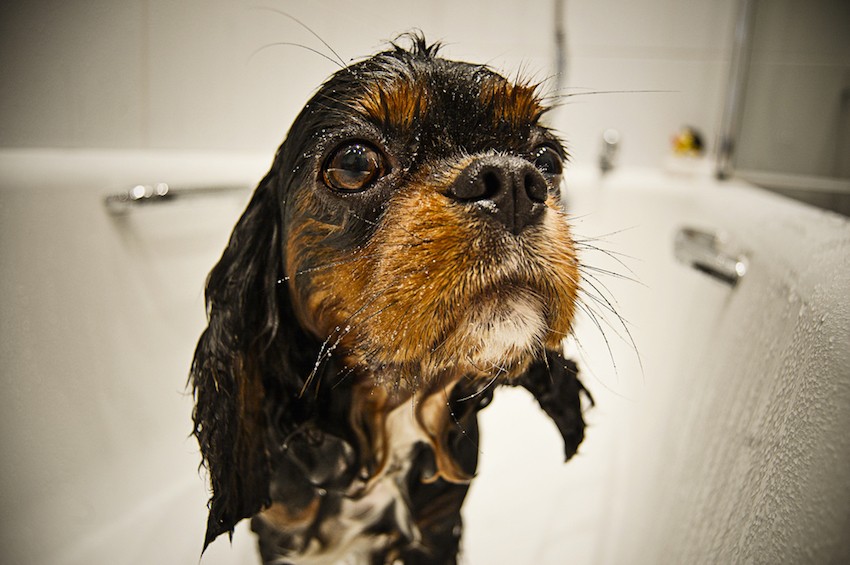What Does Seborrhea Look Like on a Dog

Dogs, just like people, can get dandruff — an annoying, unsightly skin condition.
Dandruff is dry, flaky skin. It's made up of dead skin cells that fall from the skin, looking like white flakes.
Dandruff is not normal and needs to be taken note of.
However, simple things such as daily brushing, a balanced diet and dietary supplements can go a long way to sorting the problem out.
Possible Causes of Dog Dandruff
As with humans, dandruff can be a result of many factors in your dog's health. Here are a few possibilities:
1. Seborrhea
This is a medical condition where baby skin cells travel to the surface too quickly.
The "glue" holding these cells together is weak, meaning they flake away as dandruff.
Seborrhea in a dog may be accompanied by greasy skin, as the grease glands are also overactive. The cause is unknown, but certain breeds are particularly prone to seborrhea, which points to a genetic link.
Breeds most often affected include:
- West Highland White Terrier
- American Cocker Spaniel
- Doberman Pinscher
- English Springer Spaniel
2. Cheyletiella Mites
Also referred to as "walking dandruff," cheyletiella mites make themselves comfortable in a dog's skin and coat while they lay eggs.
These white mites are large enough to see with the naked eye and have the appearance of skin flakes.
They make life miserable for your dog because they cause excessive itchiness.
3. Bacterial and Fungal Skin Infections
Infections create a vicious cycle where they drag down the skin's ability to protect itself.
Most commonly this causes hot spots or greasy patches, but in some cases it can cause flakiness and dandruff.
4. Low Humidity
If you live in an especially dry area or keep the heating high, the air in your home might be stripping your dog's skin of moisture.
Dry skin is naturally less supple, prone to flakiness and itchy, which means your dog will scratch frequently. This scratching will also worsen existing skin conditions.
5. Poor Diet
If your dog isn't getting enough water, vitamins, minerals and fat from their food, the coat will probably suffer.
Like a plant deprived of water, without proper nutrition skin becomes "sick," causing dull hair and dandruff.
6. Health Conditions
Problems such as under-active thyroid glands (hypothyroidism) and auto-immune conditions (pemphigus) can cause skin scaling and dandruff.

How to Treat Dog Dandruff (4 Simple Ways)
- Brushing: Treat your dog to a good brushing session once a day. This helps distribute the natural oils from the coat and stimulates blood supply to the skin, which promotes oil production.
- Improve the diet: Switch to a high-quality pet food and consider investing in a good nutritional supplement. Especially helpful is an omega-3 and omega-6 fatty acid supplement. Aim to give at least 35 mg of omega-3 for each kg body weight of the pet. Also, put several water dishes throughout the house so your dog will always have access to fresh water.
- Specialized shampoo: Certain pet shampoos are designed to re-moisturize the skin and relieve flakiness and irritation caused by dandruff. Keep in mind that a dandruff shampoo designed for humans will be too harsh for your dog, so using Head & Shoulders is a bad idea. Look for a soap-free, natural shampoo that's made in the USA.
- See your veterinarian: Your vet will be able to properly diagnose your dog and advise on treatment and prevention. Remember, dandruff could be a clue your pet has an infection and needs medical management, so don't ignore this important sign.
 This pet health content was reviewed for accuracy by a veterinarian, Dr. Pippa Elliott, BVMS, MRCVS. This article was originally published in 2012 and is regularly updated. It was last reviewed for accuracy and updated Aug. 25, 2019.
This pet health content was reviewed for accuracy by a veterinarian, Dr. Pippa Elliott, BVMS, MRCVS. This article was originally published in 2012 and is regularly updated. It was last reviewed for accuracy and updated Aug. 25, 2019.
If you have questions or concerns, call your vet, who is best equipped to ensure the health and well-being of your pet. This article is for informational purposes only and is not a substitute for professional medical advice, diagnosis or treatment. See additional information.
What Does Seborrhea Look Like on a Dog
Source: https://www.petful.com/pet-health/dog-dandruff-causes-treatments/

0 Response to "What Does Seborrhea Look Like on a Dog"
Post a Comment